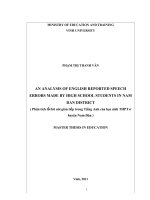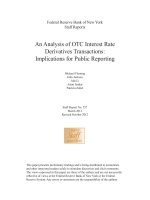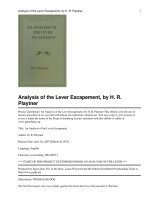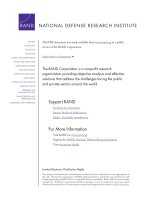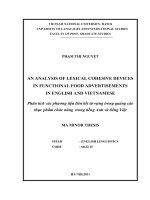An analysis of the efficiency of teaching methods applied in ESL classrooms for primary students in haiphong city
Bạn đang xem bản rút gọn của tài liệu. Xem và tải ngay bản đầy đủ của tài liệu tại đây (687.07 KB, 56 trang )
BỘ GIÁO DỤC VÀ ĐÀO TẠO
TRƯỜNG ĐẠI HỌC DÂN LẬP HẢI PHÒNG
-------------------------------
ISO 9001:2015
KHÓA LUẬN TỐT NGHIỆP
NGÀNH: TIẾNG ANH
Sinh viên
: Vũ Thị Hồng Ngọc
Giảng viên hướng dẫn : Th.S Khổng Thị Hông Lê
HẢI PHÒNG - 2018
MINISTRY OF EDUCATION AND TRANING
HAIPHONG PRIVATE UNIVERSITY
-----------------------------------
AN ANALYSIS OF THE EFFICIENCY OF TEACHING
METHODS APPLIED IN ESL CLASSROOMS FOR PRIMARY
STUDENTS IN HAIPHONG CITY
GRADUATION PAPER
Student
Class
Supervisor
: Vu Thi Hong Ngoc
: NA1802
: Khong Thi Hong Le, M.A
HAI PHONG - 2018
BỘ GIÁO DỤC VÀ ĐÀO TẠO
TRƯỜNG ĐẠI HỌC DÂN LẬP HẢI PHÒNG
--------------------------------------
NHIỆM VỤ ĐỀ TÀI TỐT NGHIỆP
Sinh viên: Vũ Thị Hồng Ngọc
SV: 1412751095
Lớp: NA1803
Ngành: Ngoại ngữ
Tên đề tài: An analysis of the efficiency of teaching methods applied in
ESL classrooms for primary students in Haiphong city
NHIỆM VỤ ĐỀ TÀI
1. Nội dung và các yêu cầu cần giải quyết trong nhiệm vụ đề tài tốt nghiệp
(về lý luận, thực tiễn, các số liệu cần tính toán và các bản vẽ).
……………………………………………………………………………..
……………………………………………………………………………..
……………………………………………………………………………..
……………………………………………………………………………..
……………………………………………………………………………..
……………………………………………………………………………..
……………………………………………………………………………..
……………………………………………………………………………..
2. Các số liệu cần thiết để thiết kế, tính toán.
……………………………………………………………………………..
……………………………………………………………………………..
……………………………………………………………………………..
……………………………………………………………………………..
……………………………………………………………………………..
……………………………………………………………………………..
……………………………………………………………………………..
……………………………………………………………………………..
……………………………………………………………………………..
3. Địa điểm thực tập tốt nghiệp.
……………………………………………………………………………..
……………………………………………………………………………..
……………………………………………………………………………..
CÁN BỘ HƯỚNG DẪN ĐỀ TÀI TỐT NGHIỆP
Người hướng dẫn thứ nhất:
Họ và tên: Khổng Thị Hồng Lê
Học hàm, học vị: Thạc sĩ
Cơ quan công tác: Đại học Dân lập Hải Phòng
Nội dung hướng dẫn: An analysis of the efficiency of teaching methods
applied in ESL classrooms for primary students in Haiphong city
Người hướng dẫn thứ hai:
Họ và tên:.............................................................................................
Học hàm, học vị:...................................................................................
Cơ quan công tác:.................................................................................
Nội dung hướng dẫn:............................................................................
Đề tài tốt nghiệp được giao ngày 06 tháng 11 năm 2018
Yêu cầu phải hoàn thành xong trước ngày 07 tháng 1 năm 2019
Đã nhận nhiệm vụ ĐTTN
Sinh viên
Đã giao nhiệm vụ ĐTTN
Người hướng dẫn
Hải Phòng, ngày ...... tháng........năm 2019
Hiệu trưởng
GS.TS.NGƯT Trần Hữu Nghị
PHẦN NHẬN XÉT CỦA CÁN BỘ HƯỚNG DẪN
1. Tinh thần thái độ của sinh viên trong quá trình làm đề tài tốt nghiệp:
……………………………………………………………………………..
……………………………………………………………………………..
……………………………………………………………………………..
……………………………………………………………………………..
……………………………………………………………………………..
……………………………………………………………………………..
……………………………………………………………………………..
2. Đánh giá chất lượng của khóa luận (so với nội dung yêu cầu đã đề ra
trong nhiệm vụ Đ.T. T.N trên các mặt lý luận, thực tiễn, tính toán số
liệu…):
……………………………………………………………………………..
……………………………………………………………………………..
……………………………………………………………………………..
……………………………………………………………………………..
……………………………………………………………………………..
……………………………………………………………………………..
……………………………………………………………………………..
……………………………………………………………………………..
……………………………………………………………………………..
3. Cho điểm của cán bộ hướng dẫn (ghi bằng cả số và chữ):
……………………………………………………………………………..
……………………………………………………………………………..
……………………………………………………………………………..
Hải Phòng, ngày … tháng … năm
Cán bộ hướng dẫn
(Ký và ghi rõ họ tên)
CỘNG HÒA XÃ HỘI CHỦ NGHĨA VIỆT NAM
Độc lập - Tự do - Hạnh phúc
PHIẾU NHẬN XÉT CỦA GIẢNG VIÊN HƯỚNG DẪN TỐT NGHIỆP
Họ và tên giảng
...................................................................................................
viên:
Đơn vị công tác:
........................................................................ ..........................
Họ và tên sinh viên:
.......................................... Chuyên ngành: ...............................
Đề tài tốt nghiệp:
...................................................................................................
........................................................... ........................................
Nội dung hướng
.......................................................... ........................................
dẫn:
1. Tinh thần thái độ của sinh viên trong quá trình làm đề tài tốt nghiệp
......................................................................................................................................
.............. ............................................................................................................................
.... ......................................................................................................................................
.... ......................................................................................................................................
.... ......................................................................................................................................
2. Đánh giá chất lượng của đồ án/khóa luận (so với nội dung yêu cầu đã đề ra
trong nhiệm vụ Đ.T. T.N trên các mặt lý luận, thực tiễn, tính toán số liệu…)
.... ......................................................................................................................................
.... ......................................................................................................................................
.... ......................................................................................................................................
.... ......................................................................................................................................
.... ......................................................................................................................................
3. Ý kiến của giảng viên hướng dẫn tốt nghiệp
Được bảo vệ
Không được bảo vệ
Điểm hướng dẫn
Hải Phòng, ngày … tháng … năm ......
Giảng viên hướng dẫn
(Ký và ghi rõ họ tên)
CỘNG HÒA XÃ HỘI CHỦ NGHĨA VIỆT NAM
Độc lập - Tự do - Hạnh phúc
PHIẾU NHẬN XÉT CỦA GIẢNG VIÊN CHẤM PHẢN BIỆN
Họ và tên giảng viên:
..............................................................................................
Đơn vị công tác:
........................................................................ .....................
Họ và tên sinh viên:
...................................... Chuyên ngành: ..............................
Đề tài tốt nghiệp:
......................................................................... ....................
............................................................................................................................
............................................................................................................................
1. Phần nhận xét của giáo viên chấm phản biện
......................................................................................................................................
......................................................................................................................................
......................................................................................................................................
......................................................................................................................................
......................................................................................................................................
......................................................................................................................................
2. Những mặt còn hạn chế
......................................................................................................................................
......................................................................................................................................
.....................................................................................................................................
......................................................................................................................................
......................................................................................................................................
......................................................................................................................................
3. Ý kiến của giảng viên chấm phản biện
Được bảo vệ
Không được bảo vệ
Điểm phản biện
Hải Phòng, ngày … tháng … năm ......
Giảng viên chấm phản biện
(Ký và ghi rõ họ tên)
ACKNOWLEDGEMENT
In the process of doing the graduation paper, I have received a lot of
assistance, guidance and encouragement from my teachers, family and friends.
First and foremost, I would like to express my deepest thanks to my
research supervisor Ms. Khong Thi Hong Le, M.A, the lecturer of foreign
language faculty, Haiphong Private University in every step throughout the
process. Without her invaluable suggestions and advice, this paper would have
never been accomplished.
I would also like to show my sincere gratitude to all the teachers of
English department at Haiphong Private University for their help as well as
useful lectures during my four-year university life at Haiphong Private
University, which have been then the foundation and inspiration for my research
paper.
Most importantly, none of this could have happened without my family
and my friends who fully supported me while I was doing this graduation paper.
Every time I was ready to quit, they were always beside me and encouraged me
and I am forever grateful. This graduation paper stands as a testament to their
unconditional love and encouragement.
Hai Phong, October 2018
Vu Thi Hong Ngoc
i
TABLE OF CONTENTS
Acknowledgement …………………………………………………………………………………………………………….i
Table of contents………………………………………………………………………………………………………………..ii
List of abbreviations………………………………………………………………………………………………………...iv
List of tables……………………………………………………………………………………………………………..……….. v
Part I. Introduction
1. The rationale…………………………………………………………………………………..………………………………6
2. Aims of the study …………………………………………………………………………………………………………7
3. Method of the study…………………………………………………………….………………………...……………..7
4. Scope of the study…………………………………………………………………………………………………………7
5. Design of the study…………………………………………………………………………...…………………………..8
Part II. Development
Chapter 1: Literature Review………………………………………………………...…………………………….9
1.1.1. A brief of English language teaching methods and approaches in
vietnam…………………………………………………………………………………………………..…….…………....9
1.2. Features of english teaching methods and techniques applied in ESL
classrooms……………………………………………………………………………………….………………………11
1.2.1. Grammar translation method…………………………………………………………………………12
1.2.2. Direct method………………………………………………………………………………………………………..13
1.2.3. Reading approach……………………………………………………...………………………………………...14
1.2.4. Audio-lingual method……………………………………………..………………………………………….15
1.2.5. Community language learning……………………………………………...…………………….….16
1.2.6. The silent way…………………………………………………………………………………………………….…16
1.2.7. Communicative language teaching………………………………..……………………….......…17
1.3. English
teaching
methods
in
primary
schools
in
Vietnam……………...……..18
Chapter 2: Methodology.................................................................................................................................................21
2.1. Participants……………………………………………………………………………...……………...................…..21
2.2. Data collection instruments and procedure……………………...................................…..21
2.2.1. Phase 1 : Questionaire………………………………………………………………….…...................……21
ii
2.2.2. Phase 2: Observation.........................................................................................................................................22
Chapter 3: Findings and discussion………………………………...........................................................…24
3.1.
3.2.
Implementation of grammar translation method…………………………...……...24
Implementation of audio-lingual method………………………………………….……....25
3.3.
Implementation of direct method…………………………………………………..…………….26
3.4.
Implementation of CLT..............................................................................................................................28
3.5.
Implementation of both direct method and CLT………………..............................29
3.6.
Implementation of reading approach……………………………………………………...…30
3.7.
Statistics from the researcher’s observation……………………………………………31
3.8.
Implications for teaching in ESL classrooms………………………….……………….33
Part III: Conclusion
1.
Summary........................................................................................................................................................................35
2.
Limitations of the study……………………………………………………………………….………….35
3.
Recommendations for further study………………………………..…………………………35
References…………………………………………………………………………………………………………….………….37
Appendices…………………………………………………………………...………………………………………………….40
iii
LIST OF ABBREVIATIONS
ALM
Audio-lingual method
CELTA
Certificate in Teaching English to
Speakers of Other Languages
CLL
Community language learning
CLT
Communicative language teaching
ESL
English as second language
GTM
Grammar translation method
MFP
Meaning Form Pronunciation
MOET
Ministry of Education and Training
TEFL
Teaching English
Language
TESOL
Teaching English to Speakers of Other
Languages
as
a
Foreign
iv
LIST OF TABLES
Table 1
Statistics of Use of Grammar Translation Method
Table 2
Teaching grammar through MFP examples and drills rather than
providing grammar rules (Audio-lingual Method)
Table 3
Statistics of Direct Method applied in class
Table 4
Statistics of CLT methods applied in class
Table 5
Variations in error correction techniques
Table 6
Statistics of use of reading approach
Table 7
Statistics from researcher’s observation
v
PART I
INTRODUCTION
1. Rationale
In the 21st century, countries from all over the world are tending to develop
basing on international cooperation. English has become crucial to the way
people interact with different people in the world; not being able to
communicate in English imposes what seem to be formidable limitations.
Therefore, English has been adopted as one of the most important subjects in
many schools, especially in primary schools in Vietnam. English has been
taught mostly by Vietnamese teachers in public schools for many years in the
traditional way, in which education was delivered through recitation and
memorization techniques. However, Sonia Jackson who wrote an interesting
blog post about modern teaching methods for Getting Smart states that the
traditional ”chalk and talk” teaching method which has existed during the past
hundred years is now requiring inferior results in comparison with modern
teaching methods used in schools at present time. Undoubtedly, in ESL
classrooms, the greater interaction among students is encouraged and the
boundaries the authority are erased and the enjoyment over grades is put a great
emphasis.
Recently, with the rising demand of being able to speak English fluently, many
people have sent their children to English center where English is taught by ESL
teachers. In ESL classrooms, whereas the modern way of doing things involves
interactive methods, English is approached through participation in many fun
classroom activities. Studying with playing will be much more effective than
only focusing on the theories. In addition, the programs using music, games also
help the lessons less boring. English programs for children that should be
combined with the introduction of short children's stories, songs, cartoons,
games themed language. This makes a great contribution to encourage children
to learn and become more confident in using English. Scholars such as Braine
(2010) and Kirkpatrick (2010) have identified a perception in the English
language teaching profession in East and Southeast Asia that native Englishspeaking teachers (NESTs) are the ideal model for language production. Their
speech is held up as the gold standard of grammatical correctness and perfect
6
pronunciation (cf. Wang, 2012), and they are valued as repositories of cultural
information
For that reason, the study was conducted with the aim of analyzing the
efficiency of teaching methods applied in ESL classrooms on primary students
in Haiphong.
2. Aims of the study
This paper is conducted with a view of finding out the efficiency of ESL
teaching methods applied for primary students compared to traditional teaching
in achieving the goal of learning English. This research is, therefore, expected to
document the significant ways of teaching English language suitable for
elementary level students and discuss the practical implementation of these
ways. Two research questions were addressed as follow:
What are common ESL teaching methods applied for primary schoolers?
How efficient are teaching methods applied in ESL classrooms?
3. Methods of the study
Considering all the characteristics, this paper made great use of both quantitative
and qualitative method.
First, a quantitative took full advantage of using the structured questions where
response options are predetermined and a large number of respondents are
involved to explore the teaching techniques and methods applied in ESL
classrooms.
Second, a qualitative approach allowed the researcher to gather non-numerical
data, which provided more opportunities for explorations after giving
information. Through observation, the method did not limit the respondents’
input to a set of predetermined responses.
4. Scope of the study
Studying the efficiency of ESL teaching methods on all elementary students in
Haiphong city is immense, so the study cannot cover all the ESL classrooms in
7
Haiphong. Therefore, my study was mainly carried out ELS classrooms within
ILA English Centre and the priority was given to ESL teachers at the centers.
5. Design of the study
This study is composed of three main parts:
Part 1 is the introduction which consists of rationale, aims, study
methods, the scope and design of the study.
Part 2 is the development- the main part of this paper which is
divided into four chapters :
- Chapter one is theoretical background of different teaching methods
applied in ESL classrooms.
- Chapter two shows detailed explanation of the methodology.
- Chapter three indicates the efficiency of ESL teaching methods and gives
useful teaching recommendations for ESL teachers in Haiphong city.
Part 3 is the conclusion which summarizes what was given in
previous parts as well as some limitations of the study and
recommendations for further study.
8
PART II. DEVELOPMENT
CHAPTER 1: LITERATURE REVIEW
1.1.
A brief of English language teaching methods and approaches in
Vietnam
It is difficult to point to a specific date when English was introduced into
Vietnam. This history of English language teaching in Vietnam can be roughly
divided into two periods: English in Viet Nam before 1986 and English in Viet
Nam from 1986 up to the present. The reason for this way of division is that
1986 was the year when the Vietnamese Communist Party initiated its overall
economic reform, exercising the open-door policy, and thus making English as
the most important language in Vietnam.
English in Vietnam before 1986
Most of the former teachers of Russians are now working as teachers of English
in Vietnam. Before 1986, Russian was a compulsory language at universities
and at many institutions the teachers of Russian far outnumbered the teachers of
English. The collapse of the Soviet Union made a great number of teachers of
Russian redundant. These teachers were retrained, usually for a two-year period,
to become teachers of English. They started the retraining programs as beginners
or false beginners in English. A few made fast progress in learning English and
have become confident with their new positions. The majority of them, however,
despite their background in teaching and learning, have reported that they have
barely benefited from the two years of retraining in terms of English language
skills and new teaching methodology. Many former teachers of Russian lack
confidence and consider themselves not qualified to teach English.
1954 – 1975 was the period when Viet Nam was divided into 2 parts – North
and South. In this period, each part of the country was politically allied with a
world superpower: North Vietnam was allied with the former Soviet Union and
South Vietnam with the USA. The status of English, thus, was different in each
part of the country. In South Vietnam, English was the dominant foreign
language; it was studied for direct interaction with the USA. In North Vietnam,
in contrast, although 4 foreign languages (Russian, Chinese, French and
English) were recognized nationally, Russian topped the list in the formal
9
educational system; and like English in the South, Russian in the North was
studied for direct interactions with the former Soviet Union. As Russian
dominated the foreign language scene in North Vietnam, English was relegated
to an inferior status. In upper secondary schools, it was taught only in some
classes in towns and in big cities as a pilot subject. (Nguyen Nhat Quang 1993:
1). At tertiary level, there were two foreign language institutions that offered
English as a discipline, namely, the Hanoi Foreign Languages Teachers’
Training College (currently The University of Languages and International
Studies, Vietnam National University Hanoi). Apart from those institutions,
some universities offered English as a subject. However, due to the limited use
of English in North Vietnam in this period, the goals of learning the language
seemed to be confined only to understanding the USA and to fighting against the
US invasion on the diplomatic front.
In this time, traditional teaching has been used by many teachers. This method,
having teachers as the centre during the classes, emphasizes taching processes
are led by teachers. Students are expected to listen to lecturers and learn by
them. Teachers give instruction based on textbooks, lectures and invididual
written assignments. Students should obey and follow teachers’ instruction.
English in Viet Nam from 1986 up to the Present
The period from 1986 up to present is characterized by the rapid growth and
expansion of English in Vietnam. This English boom began in December 1986,
when at its Six National Congress the Vietnamese Communist Party initiated an
overall economic reform known as Đổi mới ( Renovation ), opening the door of
Vietnam to the whole world. In the context of economic renovation and of the
open door policy, English becomes the first (nearly and only) foreign language
to be taught in Vietnam. It is one of the six national examinations students have
to pass if they want to get the Secondary School Certificate and is a compulsory
subject for both undergraduates and graduates at tertiary level. In a new market
economy of Vietnam with the growth of international businesses and trades, and
the increasing the number of foreign tourists, the ability to communicate in
English has become a passport to a better job not only in the tourism and
hospitality industries but in many other enterprises also. English is taught in
schools, universities and evening foreign language centers across the country.
10
There are now more teachers and students of English than of any other subjects.
Further, the Đổi mới has created mounting pressures for more and more places
to teach English at every stage of far-expanding educational system. At the same
time the fast process of globalization – the strongest external force for English
language teaching and learning in Vietnam – has made it difficult to maintain
the existing and admittedly low standards in its teaching and use. Increasingly, it
was being realized in decision-making bodies that without major changes and
sizeable inputs in its curricula and courses, methodology and materials, English
teaching in Vietnam would soon ceased effectively to serve the demands being
made on it.
Nowadays, the outstanding achievements in all fields of science, in technique as
well as of other human development, are constantly inflicting more and more
profound changes in the organization of the teaching processes to make it
perfect and to ensure easier ways for students to acquire knowledge and skills.
That is why mordern teaching methods become popular in classrooms,
especially in ESL classroom. The modern way of teaching is more acitivity
based, using questioning, explaining, demonstration and collaboration
teachniques.
1.2. Features of English teaching methods and techniques applied in ESL
classrooms
To find the best method phase of language teaching, several studies were carried
out to settle the question. For example, Swaffar, Arens and Morgan (1982) set
out to decide which was superior, audiolingualism or cognitive code learning.
The results were inconclusive, and it appeared that, that the level of classroom
teaching, few teachers adhered rigidly to one method than other. Instead, they
developed a range of practices that reflected their own personal teaching styles.
Among other things, it was studies that gradually led people to abandon the
search for the “right method”.
For a survey of the history of second or foreign language teaching, Jill Kerper
Mora (2012) discussed some important teaching methods in her recent published
newsletter “Show-Me”. Those are:
Grammar-Translation Approach
11
Direct Approach
Reading Approach
Audiolingual Method
Community Language Learning
The Silent Way
Communicative Language Teaching
1.2.1. Grammar translation method (GTM)
The grammar translation method is a method of teaching foreign languages
derived from the classical (sometimes called traditional) method of teaching
Greek and Latin. In grammar translation classes, students learn grammatical
rules and then apply those rules by translating sentences between the target
language and the native language. Advanced students may be required to
translate whole texts word-for-word. The method has two main goals: to enable
students to read and translate literature written in the source language, and to
further students' general intellectual development.
According to Richards and Rodgers (1986), Grammar Translation Method
approaches the language first through detailed analysis of rules, followed
by application of this knowledge to the task of translating sentences and
texts into and out of target language.
Every method has its own characters which should be known. Prator and CelseMurcia(1979:3) in Brown(2001:19) mentioned that the major characteristics of
GTM are:
1. Classes are taught in the mother tonge with little active use of target
language.
2. Much vocabulary is taught in the form of list of isolated words.
3. Long, elaborate explanations of the intricacies of grammar are given.
4. Grammar provides the rules for putting words together, adn instruction
often focuses on the form and inflection of words.
5. Reading of difficult classical text is begun early.
12
6. Little attenntion is paid to the content of texts, which are treated as
exercises in grammatical analysis.
7. Often the only drills are exercises in translating disconnected sentences
from the target language into the mother tongue.
8. Little or no attention of pronunciation
1.2.2. Direct method
The direct method of teaching, which is sometimes called the natural method,
and often used in teaching foreign languages, refrains from using the learner’s
native language and uses only the target language. Generally, teaching focuses
on the development of oral skills. Characterictic features of direct method are:
1. Teaching concepts and vocabulary through pantomiming, real-life
objects and other visual materials
2. Teaching grammar by using an inductive approach (i.e having learners
find out rules through the presentation of adequate linguistic forms in the target
language)
3. Centrality of spoken language
4. Focus on question-answer patterns
Some of the techniques of direct method teaching which are mentioned by
Muthuja (2009: 87) are:
1. Question/answer exercise – the teacher asks questions of any type and the
student answers.
2. Dictation – the teacher chooses a grade-appropriate passage and reads it
aloud.
3. Reading aloud – the students take turn reading sections of a passage, play
or a dialogue aloud.
4. Student self-correction – when a student makes a mistake the teacher
offers him/her a second chance by giving a choice.
5. Conversation practice – the students are given an opportunity to ask their
own questions to the other students or to the teacher. This enables both a
teacher-learner interaction as well as a learner-learner interaction.
13
6. Paragraph writing – the students are asked to write a passage in their own
words.
There are many benefits of this teaching method such as students are involved in
the process which builds confidence if they can correct themselves. Also, selfcorrected mistakes are more memorable and less likely to occur. When given
then chance to freely ask their own question, it encourages learner
independence. With two-way interaction, it gives the teacher feedback on the
student’s knowledge, ability and awareness.
1.2.3. Reading approach
Reading approach is one of the ways that helps students to solve their problem
in reading. In reading approach, students will improve their knowledge and get
something new because they are demanded to read more. For both practical and
academic reasons, this approach is chosen. Students not only study the target
language but also learn about the historical or current knowledge of the language
where it is spoken. So, in the process of studying language, reading approach
interacting and talking about the text in paticular way is essential (Casanave,
1988). In reading approach, there are some features that need to be followed:
This method confirms that students must read faster and with more
fluency if they wish to read effectively (Eskey, 1986; Anderson,
2005). Faster reading promotes reading in thought units instead of
one word at a time, and that leads to improved comprehension.
Krashen (1985) posited that the best way to improve reading is by
reading. The benefits of extensive reading include fluency,
vocabulary acquisition, awareness of grammar, models for writing,
and an immersion in the culture of the second or foreign language.
Recent work by Nation (2001), Coxhead (2000), Cobb, and others,
allow teachers to focus on the direct instruction, extensive reading,
and multiple exposures to the same words by any means necessary to
promote reading.
There are two important reading techniques applied in classrooms, namely,
skimming and scanning. First, skimming is the way of speedy reading for main
ideas. Focusing on identifying the general or main information. This technique
is useful when students have lots of material to read in a limited amount of time.
14
There are many ways that can be used when skimming. Reading the first and
last paragraph using headings, summarizes or reading the title, subtitles,
subheading and illustrations. Reading the first sentences of each paragraph is
considered. Second, scanning is a process of quickly reading to find the specific
information. In scanning, students are supposed to read the questions first and
then quickly read the paragraphs only to find the answer, ignoring unrelated
information
1.2.4. Audio-lingual method ( ALM)
This approach is similar to another, earlier method called the direct method.
Like the direct method, the ALM recommended that students should be taught a
language directly, without using students’ mother language to explain
vocabulary or grammar in the target language. However, the difference is that
ALM doesn’t focus on teaching new words but the use of grammar.
Characteristics of the teaching process:
1. New vocabulary and structural patterns are presented through dialogs.
2. Dialogs- learning through imitation, memorization and repetition.
3. Positively reinforced.
The underlying statement of this philosophy was that, as Rivers (1964) put it,
foreign language learning is basically a mechanical process of habit formation
and automatization. In practice, this meant students were presented with
language patterns and dialogues, which they had to mimic and memorize.
Language practice by and large consisted of repetition of language patterns and
drill exercises. Drill types included substitution drills, variation drills, translation
drills, and response drills.
As it was mentioned above, drills practice are typical of the Audio-lingual
method. (Richards, J.C., 1987) These include the main things such as:
Repetition: where students repeats an utterance as soon as they hear it, without
looking at printing materials. After students have repeated an utterance, they
may repeat it again and add a few words, then repeat that whole utterance and
add more words.
15
EXAMPLES. My mom bought me a skirt. – My mom bought me a skirt. My
mom bought me a red skirt 2 days ago.
Inflection: Where one word in a sentence appears in another form when
repeated
EXAMPLES. I did my homework. –I did my homework.
He did his homework - She did her homework.
Replacement: Where one word is replaced by another word
EXAMPLES. He cut the orange in half. -He cut it in half.
1.2.5. Community language learning (CLL)
Community language learning is a language-teaching method in which students
work together to improve what aspects of a language they would like to learn. It
is based on the Counselling-approach in which the teacher acts as a counsellor,
while the learner is seen as a collaborator. As Rardin and Tranel (1988) have
observed, CLL is neither student-centered, nor teacher-centered, but rather
teacher-student centered, with both make decision in the class.
The advantage of this method is that learners appreciate the autonomy CLL
offers them and thrive on analyzing their own conversations. CLL works
especially well with lower levels who are struggling to produce spoken English.
The class often becomes a real community, not just when using CLL but all of
the time. Students become much more aware of their peers, their strengths and
weaknesses and want to work as a team. On the other hands, some learners find
it difficult to speak on tape while others might find that the conversation lacks
spontaneity in the begining. Teachers can find it strange to give our students so
much freedom and tend to intervene too much.
1.2.6. The silent way
The silent way is a language teaching method created by Caleb Gattegno (1963)
that makes extensive use of silence. The method emphasizes learner autonomy
and active student participation. Silence is used as a tool to achieve this goal; the
teacher uses a mixture of silence and gestures to focus students' attention, to
elicit responses from them, and to encourage them to correct their own
errors. Pronunciation is seen as essential to the method, with a great deal of time
16
spent on it each lesson. The Silent Way uses a structural syllabus and
concentrates on teaching a small number of functional and useful words.
Translation and rote repetition are avoided, and the language is usually practiced
in meaningful contexts. Evaluation is carried out by observation, and the teacher
may never set a formal test. There are three basic principles:
- The learner needs to discover or create.
- Learning is made easier by the use of physical objects.
- Learning is made easier by problem-solving using the target language.
One example of this method is that the teacher shows the learners a small red
Cuisenaire rod and a bigger blue one and says ‘The blue one is bigger than the
red one'. The learners repeat this. The teacher then replaces the rods to produce
other models, and finally encourages the learners to produce their own
comparisons. Bruner (1966) believes that in the Silent way, learner is the key
actor rather than a bench-bound listener.
1.2.7. Communicative language teaching ( CLT)
In general, CLT is considered an approach to language teaching (LarsenFreeman, 2000; Richards and Rodgers, 2001). It is based on the theory that the
fundamental function of language use is communication and its primary goal
therefore is for learners to develop communicative competence (Hymes, 1972,
Richards and Rodgers, 2001; Ying, 2010). It means that to become proficient at
a language is to use it as a communication tools in every aspect of human life.
Communicating between lecturer and student in language learning activities is
also a knowledge transferred in systematic ways.
Hymes introduced the term ‘communicative competence’, which referred to
“that aspect of our competence that enables us to convey and interpret messages
and to negotiate meanings interpersonally within specific contexts” (as cited in
Brown, 2007, p. 246). CLT primarily aims at developing language learners’
communicative competence
CLT has become popular and widespread in second foreign language teaching
(Brown, 1994). In contradiction of the teacher-centered approach, in which
teachers are regarded as knowledge-givers and learners as receivers, CLT
reflects a more social relationship between the teacher and learner. This learner17
